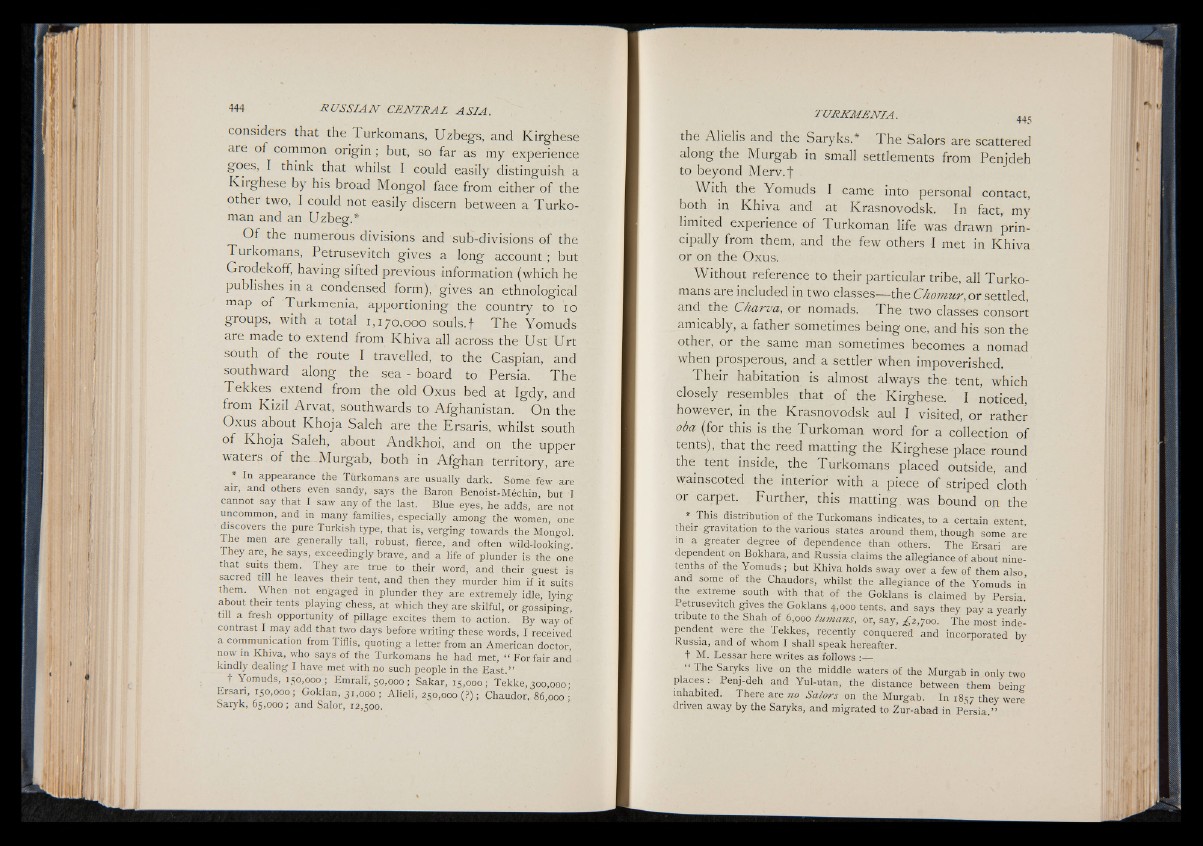
considers that the Turkomans, Uzbegs, and Kirghese
are of common origin ; but, so far as my experience
goes, I think that whilst I could easily distinguish a
Kirghese by his broad Mongol face from either of the
other two, I could not easily discern between a Turkoman
and an Uzbe' eo'.*
O f the numerous divisions and sub-divisions of the
Turkomans, Petrusevitch gives a long account ; but
Grodekoff, having sifted previous information (which he
publishes in a condensed form), gives an ethnological
map of Turkmenia, apportioning the country to 10
groups, with a total 1,170,000 souls.f The Yomuds
are made to extend from Khiva all across the Ust Urt
south of the route I travelled, to the Caspian, and
southward along the sea - board to Persia. The
Tekkes extend from the old Oxus bed at Igdy, and
from Kizil Arvat, southwards to Afghanistan. On the
Oxus about Khoja Saleh are the Ersaris, whilst south
Khoja Saleh, about Andkhoi, and on the upper
waters of the Murgab, both in Afghan territory, are
* In appearance the Turkomans are usually dark. Some few are
air, and others even sandy, says the Baron Benoist-Mechin, but I
cannot say that \ saw any of the last. Blue eyes, he adds, are not
uncommon, and in many families, especially among the women, one
discovers the pure Turkish type, that is, verging towards,the Mongol.
The men are generally tall, robust, fierce, and often wild-looking
They are, he says, exceedingly brave, and a life of plunder is the one
that suits them. They are true to their word, and their guest is
sacred till he leaves their tent, and then they murder him if it suits
them. When not engaged in plunder they are extremely idle, lying
about their tents playing chess, at which they are skilful, or gossiping,
till a fresh opportunity of pillage excites them to action. By way of
contrast I may add that two days before writing these words, I received
a communication from Ti'flis, quoting a letter from an American doctor,
now in Khiva, who says of the Turkomans he had met, “ For fair and
kindly dealing I have met with no such people in the East.”
t Yomuds, 150,000 ; Emralr, 50,000; Sakar, 15,000; Tekke, 300,000;
Ersan, 150,000; Goklan, 31,000 ; Alieli, 250,000 (?); Chaudor, 86,000 •
Saryk, 65,000; and Salor, 12,500.
the Alielis and the Saryks.* The Salors are scattered
along the Murgab in small settlements from Penjdeh
to beyond Merv.f
With the Yomuds I came into personal contact,
both in Khiva and at Krasnovodsk. In fact, my
limited experience of Turkoman life was drawn principally
from them, and the few others I met in Khiva
or on the Oxus.
Without reference to their particular tribe, all Turkomans
are included in two classes— the Chomuv, or settled,
and the CJiclyvcl, .or nomads. The two classes consort
amicably, a father sometimes being one, and his son the
other, or the same man sometimes becomes a nomad
when prosperous, and a settler when impoverished.
Their habitation is almost always the tent, which
closely resembles that of the Kirghese. I noticed,
however, in the Krasnovodsk aul I visited, or rather
oba (for this is the Turkoman word for a collection of
tents), that the reed matting the Kirghese place round
the tent inside, the Turkomans placed outside, and
wainscoted the interior with a piece of striped cloth
or carpet. Further, this matting, was bound on the
* This distribution of the Turkomans indicates, to a certain extent,
their gravitation to the various states around them, though some are
m a greater degree of dependence thati others. The Ersari are
dependent on Bokhara, and Russia claims the allegiance of about nine-
tenths of the Yomuds; but Khiva holds sway over a few of them also
and some of the Chaudors, whilst the allegiance of the Yomuds in
the extreme south with that of the Goklans is claimed by Persia.
Petrusevitch gives the Goklans 4,000 tents, and says they pay a yearly
tribute to the Shah of 6,000 tumans, or, say, ¿ 2 , 7 0 0 . The most independent
were the Tekkes, recently conquered and incorporated by
Russia, and of whom I shall speak hereafter,
t M. Lessar here writes as follows :—
“ The Saryks live on the middle waters of the Murgab in only two
places : Penj-deh and ,Yul-utan, the distance between them being-
inhabited. There are no Salors on the Murgab. In 1857 they were
driven away by the Saryks, and migrated to Zur-abad in Persia.”